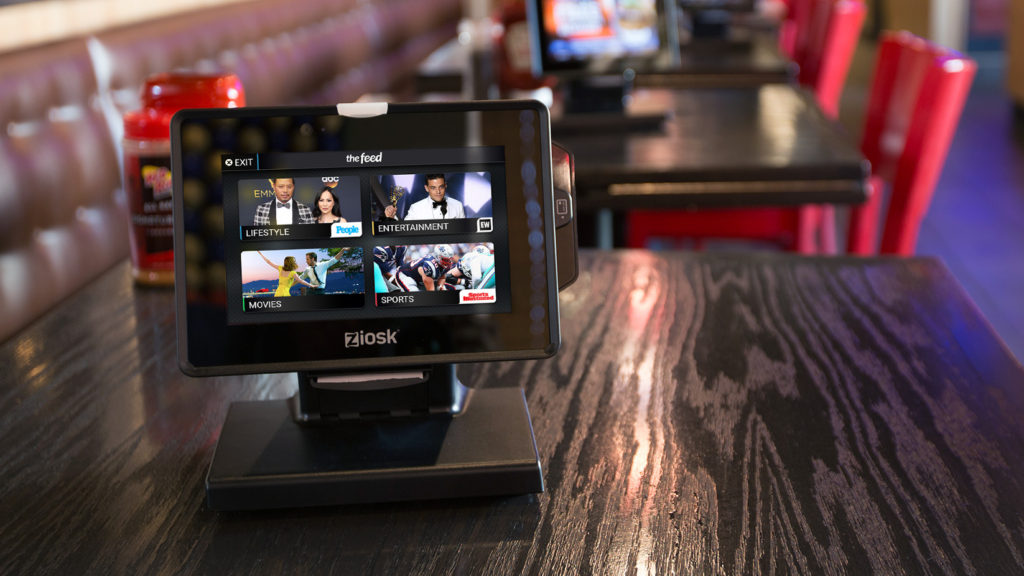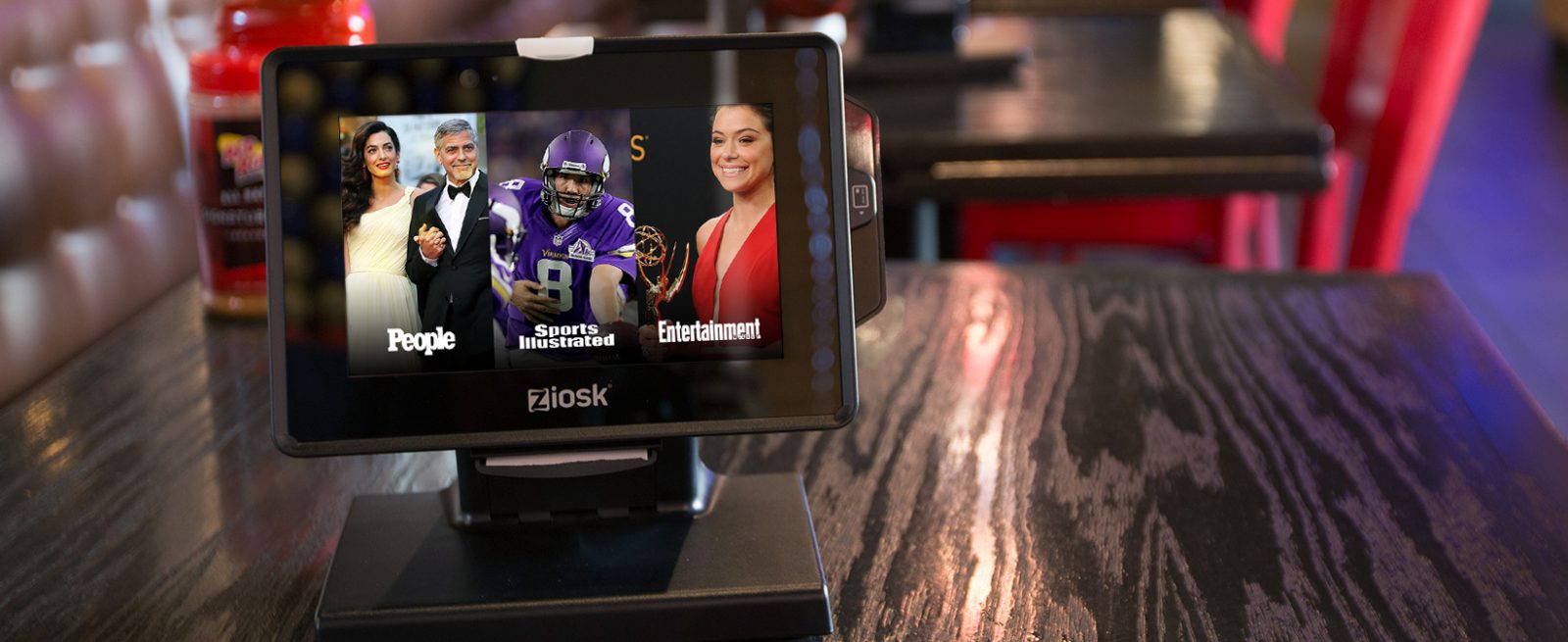Ziosk® makes the first entertainment, ordering and pay-at-the-table tablet for the restaurant market. The technology, featuring a seven-inch tablet and encrypted credit card reader enables guests to see menu items, play games, view news and entertainment, order food and beverages and ‘pay on demand, Additionally, the company created the Ziosk® Media Network, a digital media platform for partners to create engaging experiences at the point of purchase.
Modern Restaurant Management (MRM) magazine talks with John Regal, the Dallas-based company’s chief strategy and product officer, about the intersection of hospitality and technology.
How can technology (at the table and mobile) promote brand awareness?
Ziosk is constantly looking for new and innovative approaches to brand awareness. For example, Ziosk and TIME Inc. recently partnered to offer popular magazines such as People, Sports Illustrated (SI) and Entertainment Weekly (EW) that are syndicated through Ziosk’s tablet to a national network of 3,000 restaurants that offer the device. Ziosk currently has more than 180,000 tablets interacting with 50 million patrons per month. This alliance is extends the reach of TIME Inc.’s iconic brands and brings them to new audiences through off-channel distribution. The Ziosk tableside tablet adds a new dimension for marketers to align their messaging with these three brands and reach consumers through new channels.
How does technology promote efficiency in hospitality?
One of our biggest strengths and differentiators is enabling dining guests to pay directly at the table. On average, the Ziosk can shave approximately seven minutes off the table turn times, while allowing servers to have more time to interact with guests.
Additionally, Ziosk’s integration into a restaurant’s menu enables guests to order appetizers and dessert without having to wait for their server. Technology is also enabling loyalty programs to become more pervasive and easier to sign up. For example, Ziosk tablets helped Chili’s enroll more than five million restaurant guests since launching My Chili’s Rewards and now transition those members to My Chili’s + Plenti.
What trends are you seeing from diners in what they expect from technology and restaurants?
Data will always be king whether you’re a mom & pop pizzeria or large enterprise QSR.
Delivering control, convenience and efficiency to diners will remain a top trend and expectation from consumers. The Ziosk puts power and control directly in the hands of the guests, and millennials who like to be in control of things at the touch of a button love this aspect of the Ziosk. We’re also seeing technology enable greater guest satisfaction by offering a digital survey right after completing payment.
We’ve seen survey responses increase over 50x with the Ziosk, providing an unprecedented level of real-time feedback. This transformational business insight helps managers ensure guests are satisfied with the service, food and overall experience.
Another emerging trend we’re witnessing now is this notion of customer personalization. Smart restaurants now have deeper knowledge and understanding of who their customers are, how often they are coming in and what their preferences are. We’ll see this trend continue to evolve and become more sophisticated in the coming years.
What are the advantages of increasing technology use in the hospitality industry?
Countless! Some significant digital disruptions we’re seeing include mobile wallet options like Android Pay and Apple Pay; more secure payment options at-the-table through point-to-point encryption; advances in loyalty programs; harnessing the voice of the customer through post-dining surveys, and leveraging new data streams to transform and improve the way restaurants are managed.
What are myths of technology at the table?
There are misconceptions and unsubstantiated fears in the hospitality industry that technology, AI, robots, etc. will replace human servers and take away jobs. In the case with our company, the Ziosk is there to make the server’s job easier by helping them fill guests’ orders faster, and saving them time when it comes to paying the bill.
How are fears allayed regarding technology taking away from hospitality?
The more familiar and practiced diners and operators become with technology in the hospitality industry, the less fear they will have. As technology continues to be leveraged in intelligent and helpful ways, those fearing tech will soon realize that the benefits, from time and cost savings to more personalized guest experience, will begin to embrace technology.
What do you envision the restaurant table of the future looking like?
We expect to see more innovation when it comes to menu personalization and overall customer personalization. Diners will still want convenience, but there will be a growing expectation for restaurants to know who is walking through the door when it comes to knowing each specific guest’s favorite entree, wines, food allergies, and more.
In the future, restaurants will ensure each guest has a personalized experience which is designed to ensure they have an exceptional dining experience. And since everyone’s preferences are different, the recommendations for food, drink and entertainment along with pace, table location and server will vary by who the customer is. For example, some customers may value an express lunch, others may like to sit in the bar at a high table, while others enjoy sitting in the dining room and starting their meal with a glass of wine and appetizer and a more casual meal pace.
Another example of personalization is menu filtering that creates a customized menu for your specific needs. For example, If you’re allergic to shellfish, you can customize the menu and see what items there are that you can eat. Or if you’re gluten sensitive, you can look at the menu and find there are 30 items that are gluten free. This capability is not that far off. Personalization is going to be a major point of differentiation in the near future.
In what ways can independent restaurants, who might have less resources, use technology to their advantage?
Data will always be king whether you’re a mom & pop pizzeria or large enterprise QSR. More and more independent restaurants are making affordable and seamless upgrades to their point-of-sale systems, for example, so they can improve operational efficiency, driver greater revenue and enhance the overall guest experience.
In what ways can independent and franchise restaurant encourage loyalty through technology?
Simplicity and personalization of loyalty rewards are key. Restaurant operators must make singing up to their loyalty programs seamless and fast – guests don’t want to spend too much time signing up for anything. To that end, guests want to earn value and benefits through providing personal information. The rewards offered should be tailored to guests’ preferences as much as possible so they are appropriately enticed to return for another dining experience.


